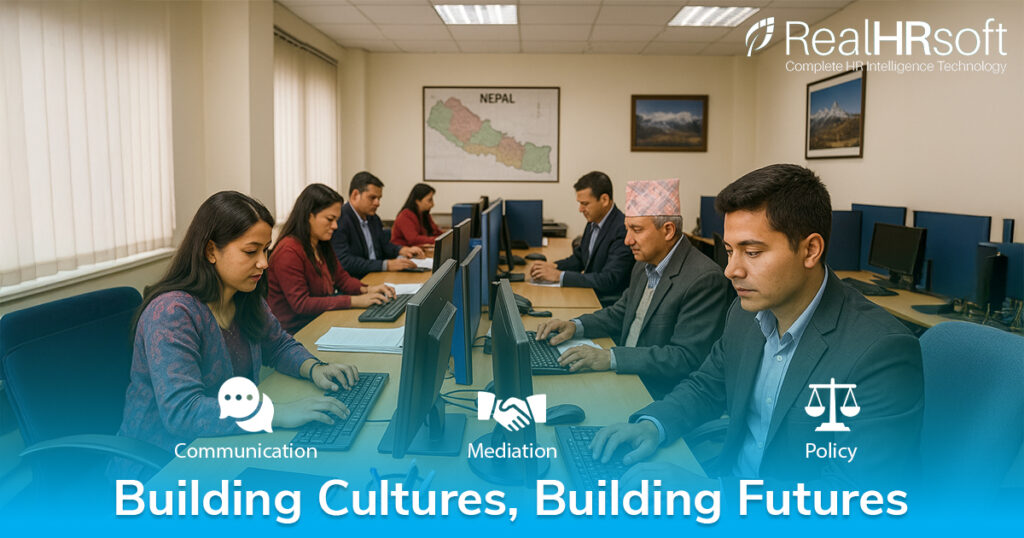Is Your Workplace Conflict a Hidden Threat or an Unseen Opportunity?
In the vibrant, fast-paced world of Nepali business, conflict is inevitable. From Kathmandu’s bustling startups to the established enterprises in Pokhara, diverse personalities, communication styles, and expectations often collide. But here’s the game-changer: conflict itself isn’t the problem. It’s how you manage it that determines your organization’s destiny. Are unresolved disputes silently draining your team’s energy, stifling innovation, and perhaps even risking legal challenges? Or are you ready to transform conflict into a powerful catalyst for growth, innovation, and stronger relationships? For aspiring HR leaders and savvy business owners in Nepal, mastering conflict resolution isn’t just a best practice; it’s a strategic imperative.
Unlock Harmony, Productivity, and Legal Confidence – The Nepali Way
Imagine a workplace where disagreements lead to brilliant new ideas, where challenges strengthen team bonds, and where every employee feels heard and respected. This isn’t a dream; it’s the tangible outcome of a strategically implemented conflict resolution framework. We’re not just talking about “putting out fires.” We’re talking about building a resilient organizational culture that thrives on open communication and mutual understanding, all while navigating the unique socio-cultural nuances and legal landscape of Nepal.
Why is this crucial for your Nepali enterprise?
- Boosted Innovation & Problem-Solving: Healthy debate, channeled constructively, unlocks diverse perspectives, leading to more creative and effective solutions. Think of it as harnessing the power of a panchayat (local council) for your business decisions – where diverse voices contribute to the best outcome.
- Enhanced Employee Retention & Morale: When employees trust the system and feel psychologically safe, their job satisfaction soars, reducing costly turnover and fostering loyalty (a deeply valued trait in Nepali organizational culture).
- Stronger Organizational Culture: Proactive conflict management reinforces core Nepali values like sahayog (cooperation) and aatmiyata (camaraderie), shaping a truly positive and inclusive work environment.
- Mitigated Legal Risks & Costs: Effective internal resolution can prevent disputes from escalating into lengthy, expensive, and reputation-damaging legal battles, keeping you compliant with Nepali labor laws.
- Improved Reputation & Talent Attraction: Companies known for fair and effective internal dispute resolution become magnets for top talent in Nepal’s competitive market, enhancing your saakh (reputation).
Your Blueprint for a Harmonious & Compliant Workplace
So, how do you achieve this transformative shift? It begins with a comprehensive, culturally sensitive, and legally sound strategy.
- Cultivate Open Communication: The Foundation of Trust Communication breakdowns are the root of many conflicts. In Nepal, where direct confrontation can sometimes be culturally avoided, fostering safe spaces for dialogue is paramount.
- Actionable Steps: Establish regular team check-ins, implement anonymous feedback channels (e.g., salah-sujhaav peti – suggestion box), and provide training on giving and receiving constructive feedback. Leaders must model transparency and approachability, breaking down hierarchical barriers (a common feature in Nepali organizational structures) to ensure junior staff feel comfortable voicing concerns. Ensure information flow via diverse channels, including those accessible to all literacy levels.
- Master Active Listening: Hearing Beyond the Words True listening goes beyond hearing; it’s about understanding. In the Nepali context, this means discerning not just spoken words but also unspoken cues and cultural nuances.
- Actionable Steps: Conduct workshops on active listening techniques, emphasizing empathy, paraphrasing, and non-verbal cues. Encourage one-on-one dialogues and provide coaching on understanding underlying concerns, especially when direct expression might be culturally constrained.
- Embrace Neutral Mediation: Bridging Divides When direct resolution falters, a neutral third party can be a beacon. HR professionals in Nepal are ideally positioned for this role.
- Actionable Steps: Designate and train internal mediators (HR, senior managers) with strong impartiality and empathy. Establish a clear, structured mediation process: separate meetings, joint sessions focusing on common ground, solution brainstorming, and documented agreements. Emphasize that mediation helps save “face” (ijjat) and preserves valuable relationships – vital in Nepali professional and social networks.
- Establish Robust Conflict Resolution Policies: Your Legal & Operational Safeguard Clear policies are your organizational compass, ensuring fairness, consistency, and compliance. These are particularly critical given Nepal’s evolving legal landscape.
- Actionable Steps: Develop a comprehensive policy document detailing step-by-step procedures for reporting and resolving issues (from informal to formal), behavioral guidelines, and responsibilities of employees, managers, and HR. Ensure robust confidentiality and non-retaliation clauses. Crucially, disseminate these policies in Nepali language and conduct thorough training for all employees, recognizing varying literacy levels.
- Nepali Labor Law & Related Acts – Your Compliance Checklist:
- Labor Act, 2074 B.S. (2017): Your internal policies must align with this foundational law. For individual grievances, ensure employees know their right to escalate to the Labor Office or Labor Court if internal resolution fails. For collective disputes, your policy must respect the legal process of negotiations, mediation by the Labor Relations Committee, and potential arbitration or legally sanctioned strikes. Understanding the nuances of “Protected Work” and “Essential Services” under this act is also vital.
- Sexual Harassment at Workplace (Prevention) Act, 2071 (2015): This act is non-negotiable. Your policy must include provisions for preventing sexual harassment, mandating internal complaint mechanisms, ensuring awareness, and outlining procedures for escalation to the Chief District Officer (CDO) if necessary. Compliance is critical to avoid severe penalties.
- Trade Union Act, 2049 (1992): Be prepared to engage with trade unions according to this act. Your internal policies should accommodate collective bargaining processes, ensuring a structured approach to collective demands and preventing industrial unrest.
- Contribution Based Social Security Act, 2074 (2017): While focused on benefits, a clear and compliant social security system is fundamental. Misunderstandings or non-compliance here can become a significant source of conflict. Ensure transparency regarding contributions and benefits.
- Focus on Interests, Not Just Positions: Digging Deeper Move beyond “what” people want to “why” they want it.
- Actionable Steps: Train employees and managers in interest-based negotiation, asking open-ended questions that uncover underlying needs, fears, or aspirations. Foster empathy to understand the motivations behind demands.
- Aim for Win-Win Solutions: Collaborative Growth Seek outcomes that provide value to all parties, fostering a culture of shared success.
- Actionable Steps: Conduct workshops on collaborative problem-solving. Teach brainstorming techniques for generating diverse solutions. Equip teams with negotiation skills focused on mutual benefit, guided by mediators to find creative, acceptable resolutions.
- Invest in Emotional Intelligence (EQ) Training: Building Resilient Individuals Empower your team with the skills to navigate emotions constructively.
- Actionable Steps: Offer workshops on self-awareness, self-regulation, empathy, and social skills. In the Nepali context, EQ training is especially crucial for navigating indirect communication styles and managing emotional responses respectfully. It empowers individuals to express concerns assertively yet politely, bridging cultural communication gaps.
- Strategic Follow-Up: Sustaining Harmony Resolution is just the beginning. Consistent follow-up reinforces trust and prevents recurrence.
- Actionable Steps: Schedule follow-up meetings (1-2 weeks post-resolution). Solicit honest feedback about effectiveness, and be prepared to adjust plans. Maintain thorough documentation of conflicts and resolutions to identify patterns and areas for systemic improvement.
Transform Your Workplace Today!
The future of your Nepali business depends on how effectively you handle conflict. Don’t let unresolved disputes hold you back. By implementing these strategic, culturally sensitive, and legally compliant conflict resolution strategies, you’re not just solving problems—you’re building a more resilient, innovative, and harmonious workplace.
Ready to lead the change? Start by reviewing your current conflict resolution practices against these strategic guidelines. Train your HR team, empower your managers, and instill a culture where conflict becomes a stepping stone, not a stumbling block. Let’s build a future of harmonious and thriving workplaces across Nepal. Chito garnuhos!
Reach out to us to help you handle it right through our expert HR consulting services!
[info@aayulogic.com] +977-9802-075555





